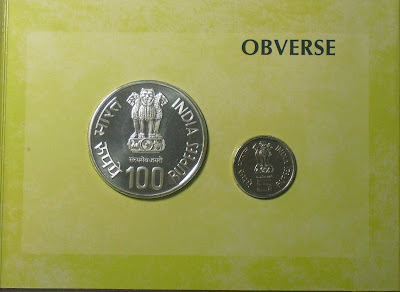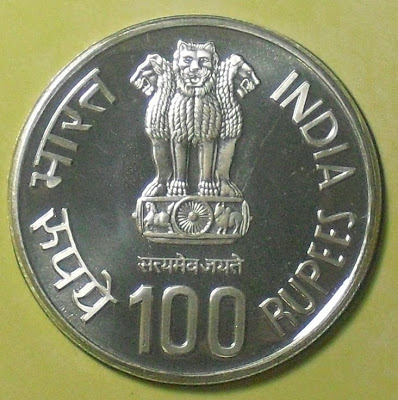"partaap Ne Jaan De Di Vatan Pe shivaaji Ne Bhagava Udaaya Gagan Pe maradon Ne Khaayin Aazaadi Ki Kasamein ada Auraton Ne Ki Jauhar Ki Rasmein kafan Baandh Kar Raani Jhaansi Pukaari ye Desh Aazaad hoke rahega siraaj Aur Tipu Zafar Aur Naana tha Har Ek Inamein Qaumi Divaana yahaan Le Ke Aaye Bagaavat Ki Aandhi tilak Neharu Aazaad Netaaji Gaandhi bhagat Sinh Ki Raakh Ne Pukaara ye Desh Aazaad hoke rahega" This set was released on the completion of 150 years of the first war of independence. The reverse shows two persons firing a cannon at the bottom and some warriors on horseback flanked by the figures of Bahadur Shah Zafar on the right and Tatya Tope on the left, who were two major cogs in the wheel of the war. Bahadur Shah zafar was the last Mughal emperor. He was the ruler of Delhi and was also the weakest link in the revolt. The East India company made its arrival in India in the time when Mughal emperor Jahangir reigned, at around 1616 AD. They came originally as traders, but slowly and steadily kept expanding their power and influence. Their aspirations and desires grew in India and one by one, they started to take over different princely states and sultanates through various means like agreement, deceit, and also conquest. Many states were taken over through the doctrine of lapse, which stated that any adopted heir was not recognized as a legal heir, and the rulers like rani Laxmi Bai of Jhansi thought of this as an interference in the traditional inheritance policy.In some cases the local princes were not accepted as the rulers because of being underage and were killed, like Birjis Qadar of Awadh/Oudh. Unrest grew among the princely states as one by one the British were taking over the rule from the princes. Most of the practices followed by the British were also not acceptable to the devoutly religious Indians. One such practice was the rumored use of pork and beef in bullet cartridges in the enfield rifles that were given to the Indian sepoys in the British army. Pork is anathema for Muslims and beef is taboo for Hindus. So Muslims and Hindus both were agitated by the British rule and practices. In march 1857, Mangal Pandey refused to bite off the cartridges from the enfield rifles that were provided to them and this was the trigger in the outbreak of the revolt, which had been brewing for quite some time. One by one, the different states declared war on the British during that year only. Eminent leaders in the war for independence from British rule included rani Laxmi Bai of Jhansi, Tatia Tope, Bahadur Shah Zafar, Tipu Sultan, Rani Chennamma, begum Hazrat Mahal, Nana Saheb Peshwa and the 80 year old Kunwar Singh of Bihar. Most of the revolt was on the part of the aristocracy who were highly insecure because of their reign being taken over by the British. The participation on the part of the zamindars, taluqdars and the peasantry was very limited.
This set was released on the completion of 150 years of the first war of independence. The reverse shows two persons firing a cannon at the bottom and some warriors on horseback flanked by the figures of Bahadur Shah Zafar on the right and Tatya Tope on the left, who were two major cogs in the wheel of the war. Bahadur Shah zafar was the last Mughal emperor. He was the ruler of Delhi and was also the weakest link in the revolt. The East India company made its arrival in India in the time when Mughal emperor Jahangir reigned, at around 1616 AD. They came originally as traders, but slowly and steadily kept expanding their power and influence. Their aspirations and desires grew in India and one by one, they started to take over different princely states and sultanates through various means like agreement, deceit, and also conquest. Many states were taken over through the doctrine of lapse, which stated that any adopted heir was not recognized as a legal heir, and the rulers like rani Laxmi Bai of Jhansi thought of this as an interference in the traditional inheritance policy.In some cases the local princes were not accepted as the rulers because of being underage and were killed, like Birjis Qadar of Awadh/Oudh. Unrest grew among the princely states as one by one the British were taking over the rule from the princes. Most of the practices followed by the British were also not acceptable to the devoutly religious Indians. One such practice was the rumored use of pork and beef in bullet cartridges in the enfield rifles that were given to the Indian sepoys in the British army. Pork is anathema for Muslims and beef is taboo for Hindus. So Muslims and Hindus both were agitated by the British rule and practices. In march 1857, Mangal Pandey refused to bite off the cartridges from the enfield rifles that were provided to them and this was the trigger in the outbreak of the revolt, which had been brewing for quite some time. One by one, the different states declared war on the British during that year only. Eminent leaders in the war for independence from British rule included rani Laxmi Bai of Jhansi, Tatia Tope, Bahadur Shah Zafar, Tipu Sultan, Rani Chennamma, begum Hazrat Mahal, Nana Saheb Peshwa and the 80 year old Kunwar Singh of Bihar. Most of the revolt was on the part of the aristocracy who were highly insecure because of their reign being taken over by the British. The participation on the part of the zamindars, taluqdars and the peasantry was very limited.
Mangal Pandey's fellow regiment men refused to arrest him, but he was unable to ignite an open rebellion. He tried to fire himself with his musket for his failure, but only wounded himself. He was later court martialled and hanged. The fallback of the rebellion started by Mangal Pandey was that it was not organized revolt, everyone declared war one by one. Had the revolt broken out in a coordinated manner, the British would have had a tough time. Another reason for the failure of the revolt was the non-participation of various factions like the Sikhs and the Pathans of North West Frontier Province and Punjab. Most people believe that this was because earlier the British had conquered Punjab only because the British had got inside help from Purbias(Bengalis and Marathis- Easterner), and the sepoys were despised far more than the British by these communities at that time.
So as a foregone conclusion, the revolt was crushed and every involved person had to face dire consequences. A no prisoner policy was adopted and mass executions were carried out with muskets , and also a large number of people were bound to cannons and blown to pieces, like with the Namdhari Sikhs. Bahadur shah Zafar was exiled to Rangoon where he died later. Many leaders were blown by cannons, and there was large scale massacre. Women were spared but the men and the children were heartlessly killed. We are talking of civilians here, who did not take part in the revolt. Shockingly, the brutal aftermath of the reconquest was approved and also lauded of back in England as some accounts said the orientals were uncivilized and had done wrong to the Europeans there , and that several young European girls were raped by them. Still , some people in the British army themselves did not approve of the inhuman and savage acts of suppression. People like Karl Marx have pointed out that the accounts of Indians acting as uncivilized and brutal people were biased , and in some cases, the person giving the account was not even present at the mentioned event.
The conclusion of the revolt of 1857 was that there was mass, brutal suppression and the Crown of England, at that time Queen Victoria took over the reins of colonial domination, and she became Empress Victoria.
See also: First war of independence proof set









No comments:
Post a Comment